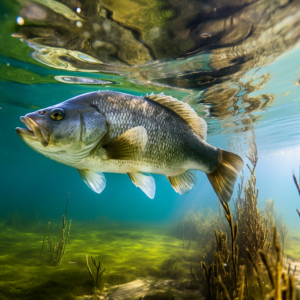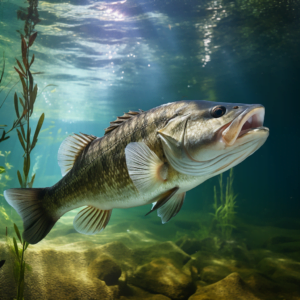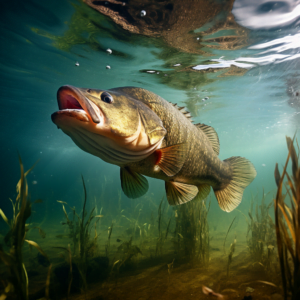Have you ever wondered what makes a largemouth bass a good catch? Well, let me tell you, there are a few key factors that determine just how appealing this fish is to anglers. In this article, we’ll dive into the details and explore what exactly sets a largemouth bass apart from other species. So, if you’re an avid angler or just looking to learn more about fishing, keep reading!
First and foremost, largemouth bass are known for their size and strength. These fish can grow to impressive lengths and weights, making them a formidable opponent for any angler. When you hook into a largemouth bass, be prepared for a thrilling fight as they try to outmuscle you and break free. And let me tell you, there’s nothing quite like the satisfaction of reeling in a sizeable largemouth bass.
But it’s not just their size that makes largemouth bass a prized catch. They also exhibit some unique behaviors that make them challenging and exciting to pursue. Largemouth bass are known for their ambush feeding strategy, which means they lie in wait and strike at their prey with lightning-fast speed. This makes them a cunning and intelligent adversary that requires skill and strategy to catch. So, if you’re up for the challenge, fishing for largemouth bass is definitely a thrilling experience.
In addition to their size and behavior, largemouth bass also offer an excellent taste and culinary value. Many anglers target largemouth bass specifically for their delicious, white, flaky meat. Whether you prefer to cook them up in a pan or on the grill, largemouth bass make for a tasty meal that you can enjoy with family and friends. So, not only do you get the satisfaction of catching a prized fish, but you also get to savor the fruits of your labor when it comes to mealtime.
In conclusion, largemouth bass are a highly sought-after catch for a variety of reasons. Their size, strength, unique behaviors, and culinary value all contribute to their appeal. Whether you’re an experienced angler or just starting out, fishing for largemouth bass is sure to provide you with an exciting and rewarding experience. So, if you’re interested in learning more about how to catch largemouth bass or simply want to appreciate these remarkable fish, be sure to check out our article for further insights. Happy fishing!

Largemouth Bass: An Introduction
| Lure Type | Spring | Summer | Fall | Winter | Notes |
|---|---|---|---|---|---|
| Crankbaits | High | Medium | High | Low | Effective in various depths; mimic baitfish. |
| Soft Plastic Worms | High | High | Medium | Low | Versatile; can be rigged in various ways. |
| Spinnerbaits | Medium | High | Medium | Low | Ideal for weedy areas; continuous motion. |
| Topwater Lures | Medium | High | High | Low | Best used in warm months; mimic prey on surface. |
| Jigs | High | Medium | High | Medium | Good for deeper water; mimic crawfish or small fish. |
Overview of the Largemouth Bass
The largemouth bass, scientifically known as Micropterus salmoides, is a freshwater fish that is highly popular among recreational anglers. Known for its aggressive feeding habits and impressive size, the largemouth bass offers a thrilling fishing experience like no other. This article will explore the various factors that make a largemouth bass a good catch, including its size and weight, fight and aggression, preferred fishing techniques, and optimal catching season.
Habitat and Distribution
Largemouth bass are primarily found in North America, inhabiting a wide range of freshwater environments, such as lakes, reservoirs, rivers, and ponds. They prefer areas with adequate vegetation cover, such as submerged plants, fallen trees, and aquatic grasses, as they provide shelter and ambush points for these voracious predators. Largemouth bass are most commonly found in the southern and central parts of the United States, although they have been introduced and are now thriving in many other regions as well.
Physical Characteristics
Largemouth bass are easily recognizable due to their unique appearance. They have a large mouth that extends beyond the eyes, giving them their name. Their bodies are torpedo-shaped, with a dark green color on their dorsal side and a lighter shade on their ventral side. They also possess a lateral line running along their sides, which is a sensory organ used to detect movement and vibrations in the water.
Behavior and Feeding Habits
Largemouth bass are known for their aggressive feeding habits, making them a highly sought-after species among anglers. They are opportunistic predators that feed on a wide range of prey, including smaller fish, frogs, crayfish, and even small mammals. They have excellent visual acuity and rely heavily on their sight to locate and ambush their prey.
Largemouth bass are most active during dawn and dusk when they venture out from their cover in search of food. They often hide in vegetation or near structures, patiently waiting for an unsuspecting prey to swim by. Once they spot their target, they will launch a lightning-fast attack, engulfing their prey in one swift movement.
Factors That Make a Largemouth Bass a Good Catch
Size and Weight
One of the primary factors that make a largemouth bass a good catch is its impressive size and weight. Largemouth bass can grow to be quite large, with the record for the heaviest largemouth bass weighing in at 22 pounds, 4 ounces. Catching a bass of such size is a remarkable feat and a dream come true for many anglers.
Fight and Aggression
Another factor that makes largemouth bass a good catch is their incredible fighting ability and aggression. When hooked, largemouth bass will put up a fierce fight, often leaping out of the water and thrashing violently in an attempt to free themselves. This makes them an exciting challenge for anglers and adds to the thrill of the catch.
Preferred Fishing Techniques
To catch largemouth bass successfully, it is important to understand and employ the preferred fishing techniques for this species. Largemouth bass can be caught using various methods, including casting and retrieving, using live bait, jigging, and skipping techniques, as well as topwater fishing techniques. Each technique has its advantages depending on the prevailing conditions, such as water temperature, clarity, and the presence of cover.
Optimal Catching Season
The optimal catching season for largemouth bass varies depending on the region and water conditions. In general, largemouth bass are most active during the spring and fall seasons when water temperatures are cooler. During these periods, bass move closer to the shallows in preparation for spawning and are more aggressive in their feeding behavior. However, largemouth bass can still be caught year-round with the right techniques and approaches, even during the hot summer months or cold winter days.
Lure Selection for Largemouth Bass Fishing
Understanding Largemouth Bass Behavior
To select the right lure for largemouth bass fishing, it is essential to understand their behavior and feeding patterns. Largemouth bass are ambush predators that rely on their sight to locate prey. They are attracted to objects that mimic their natural prey and trigger their instinct to strike. By observing their behavior and knowing what they feed on in a particular body of water, anglers can choose lures that closely resemble their prey and increase their chances of a successful catch.
Types of Lures for Different Conditions
There are various types of lures available for largemouth bass fishing, each designed for different fishing conditions and techniques. Some common types of lures include crankbaits, soft plastic worms, spinnerbaits, topwater lures, and jigs. Anglers can experiment with different lures to find the ones that work best in specific situations, such as water clarity, depth, and cover.
Top Lures for Largemouth Bass Fishing
While the effectiveness of lures can vary depending on the location and prevailing conditions, there are some top lures that have proven to be consistently successful for largemouth bass fishing. These include the classic plastic worm, which can be rigged in various ways to mimic a wounded baitfish or a stationary worm, as well as topwater lures like buzzbaits and poppers, which create surface disturbance and attract feeding bass.

Fishing Techniques for Largemouth Bass
Casting and Retrieval Techniques
Casting and retrieval techniques are widely used for largemouth bass fishing. This involves casting the lure, allowing it to sink or float, and then retrieving it with various actions to imitate the movements of live prey. The key to successful casting and retrieval techniques is to vary the speed, depth, and action of the lure to mimic the behavior of the bass’s prey and trigger an aggressive strike.
Using Live Bait
Using live bait is another effective technique for catching largemouth bass. Live bait, such as minnows, shiners, or nightcrawlers, can be rigged on a hook and presented to the bass in a natural and enticing manner. The scent and movement of live bait can be highly attractive to largemouth bass, increasing the chances of a successful catch.
Jigging and Skipping Techniques
Jigging and skipping techniques are popular for targeting largemouth bass in areas with heavy cover, such as brush piles, fallen trees, or docks. Jigging involves using a lead-headed jig with a soft plastic trailer, allowing it to sink to the desired depth and then imparting an enticing action by jerking the rod tip. Skipping involves casting a lure under low-hanging structures or docks, making it skip across the water’s surface to get the attention of lurking bass.
Topwater Fishing Techniques
Topwater fishing techniques are exhilarating and can yield impressive results when targeting largemouth bass. These techniques involve using lures that float or skim across the water’s surface, creating noise and commotion that attracts bass. Topwater lures, such as poppers, frogs, or buzzbaits, can be worked in various ways to imitate wounded prey or simulate the movements of a fleeing baitfish.
Tips and Tricks for Catching Largemouth Bass
Location and Structural Awareness
To increase your chances of catching largemouth bass, it is important to be keenly aware of your surroundings and focus on areas where bass are likely to be found. Pay attention to cover, such as submerged vegetation, fallen trees, or rock formations, as largemouth bass often hide in these areas to wait for prey. Also, be observant of changes in the water’s depth, structure, and temperature, as these can impact the bass’s feeding behavior and movement.
Finding the Best Fishing Spots
Finding the best fishing spots for largemouth bass is a combination of knowledge, experience, and exploration. Look for areas with adequate vegetation cover and structures that provide hiding places for bass. Additionally, pay attention to underwater features such as drop-offs, ledges, or points, as these can concentrate baitfish and attract bass. It can take time to identify the best spots, but with patience and persistence, you will uncover the hidden hotspots where the bass are waiting.
Weather and Water Conditions
Weather and water conditions play a significant role in largemouth bass behavior and feeding patterns. Pay attention to the weather forecast, as changes in temperature, barometric pressure, and cloud cover can impact bass activity. Additionally, consider the water clarity, as largemouth bass may be more or less aggressive depending on how easily they can see their prey. Adjust your fishing techniques and lure selection based on the prevailing conditions to maximize your chances of success.
Patience and Persistence
Catching largemouth bass requires patience and persistence. Bass can be elusive and may not always strike immediately, so it is important to remain focused and persistent. Be willing to experiment with different techniques, lures, and areas until you find what works best. Remember, fishing is not just about the catch itself but the joy of being in nature and enjoying the serenity it offers.
Conservation and Responsible Largemouth Bass Fishing
Catch and Release Principles
Conservation and responsible fishing practices are essential for the long-term sustainability of largemouth bass populations. Catch and release principles advocate for releasing all or most of the caught bass back into the water, allowing them to spawn and contribute to future generations. This practice ensures a healthy and balanced fishery while preserving the excitement of the catch for future anglers.
Proper Handling Techniques
When practicing catch and release, it is essential to handle the bass properly to minimize stress and potential injury. Wet your hands before touching the fish to prevent removing its protective slime coat. Use needle-nose pliers or a de-hooking tool to safely remove the hook, minimizing injury to both the fish and yourself. Hold the bass horizontally, supporting its weight, and avoid squeezing its internal organs or gills. Gently release the fish into the water, allowing it to swim away on its own.
Protecting Largemouth Bass Habitats
Preserving largemouth bass habitats is crucial for their survival and long-term well-being. Avoid damaging vegetation or disturbing the underwater habitat when fishing. Respect protected areas and adhere to local regulations and guidelines. Additionally, consider participating in habitat restoration projects or volunteering with organizations that work to preserve and protect the natural ecosystems that largemouth bass and other species rely on.
Competitive Bass Fishing
The World of Tournament Fishing
Competitive bass fishing has gained immense popularity, with tournaments held worldwide that attract skilled anglers and enthusiastic spectators. These tournaments typically involve anglers competing to catch the heaviest or largest number of bass within a designated timeframe. The world of tournament fishing offers an opportunity for anglers to showcase their skill and craftsmanship while promoting the sport and conservation efforts.
How to Prepare for a Bass Fishing Tournament
Preparing for a bass fishing tournament involves thorough research, planning, and practice. Familiarize yourself with the tournament rules and regulations, as well as the specific body of water and its characteristics. Study the behavior and patterns of largemouth bass in that particular location to determine the most effective fishing techniques and lures to use. Practice casting, retrieving, and working your chosen lures to build confidence and increase your chances of success during the tournament.
Strategies and Techniques for Competitive Fishing
Competitive fishing requires precision, adaptability, and the ability to quickly assess the prevailing conditions and adjust your strategies accordingly. Focus on areas that are less crowded or have received less fishing pressure, as the bass there may be more willing to bite. Experiment with different lure presentation techniques and vary your fishing depth and speed to trigger a strike. Pay attention to the leaderboard and the progress of other anglers, but trust your instincts and stick to your own game plan.
The Ecological Importance of Largemouth Bass
Role in Aquatic Ecosystems
Largemouth bass play a crucial role in aquatic ecosystems, as they help maintain a balanced population structure and control the abundance of smaller fish species. By preying on smaller prey, largemouth bass can prevent overpopulation and ensure the survival of healthier and more genetically diverse fish populations. This helps maintain the overall health and productivity of freshwater ecosystems.
Predation and Population Control
Largemouth bass are apex predators that regulate the populations of smaller fish species within their habitat. Through predation, bass keep populations in check and prevent overcrowding, competition for resources, and the spread of diseases. The active and aggressive feeding habits of largemouth bass contribute to a healthy and diverse fish community by keeping certain species from dominating the ecosystem.
Impact on Other Fish Species
While largemouth bass play a vital role in maintaining the balance of aquatic ecosystems, their voracious nature can also impact other fish species. They are known to prey on smaller game fish, such as bluegill or crappie, which can have implications for anglers targeting these species. However, when managed responsibly, largemouth bass populations can coexist with other fish communities, contributing to a thriving aquatic ecosystem.
Famous Largemouth Bass Anglers and Their Stories
Legends of Bass Fishing
Over the years, numerous legendary bass anglers have left their mark on the sport, revolutionizing techniques, and capturing the hearts of fishing enthusiasts worldwide. Anglers like Bill Dance, Roland Martin, and Kevin VanDam have achieved remarkable success in competitive bass fishing, winning numerous tournaments and setting records that still stand today. Their dedication, passion, and innovative approaches have paved the way for future generations of anglers.
Notable Catch Records
The world of largemouth bass fishing boasts an impressive collection of notable catch records. The current world record for the heaviest largemouth bass stands at 22 pounds, 4 ounces and was caught by George Perry in 1932. This record-breaking catch continues to captivate the imagination of anglers and serves as a testament to the remarkable size and fighting ability of largemouth bass.
Influential Bass Fishing Personalities
In addition to legendary anglers, there are influential personalities within the bass fishing community who have made significant contributions to the sport. Television hosts, such as Bill Dance and Jimmy Houston, have educated and entertained millions of viewers through their fishing shows, sharing their knowledge, experiences, and love for the sport. These influential figures have inspired countless anglers and helped popularize largemouth bass fishing on a global scale.
Conclusion
In conclusion, a largemouth bass can be considered a good catch for several reasons. Its impressive size, fierce fighting ability, and preferred fishing techniques make it a highly sought-after species among anglers. Understanding largemouth bass behavior, selecting the right lures, and employing various fishing techniques can significantly increase your chances of success. It is important, however, to practice responsible fishing and conservation principles to ensure the long-term sustainability of largemouth bass populations and their habitats. So, next time you head out to the water in search of the ultimate fishing experience, keep these factors in mind and appreciate the thrill of catching a largemouth bass. Happy fishing!




